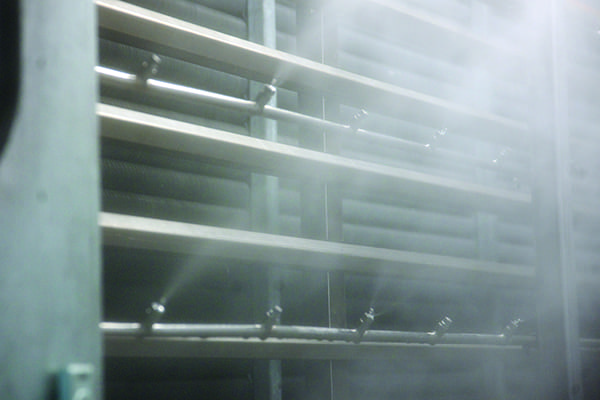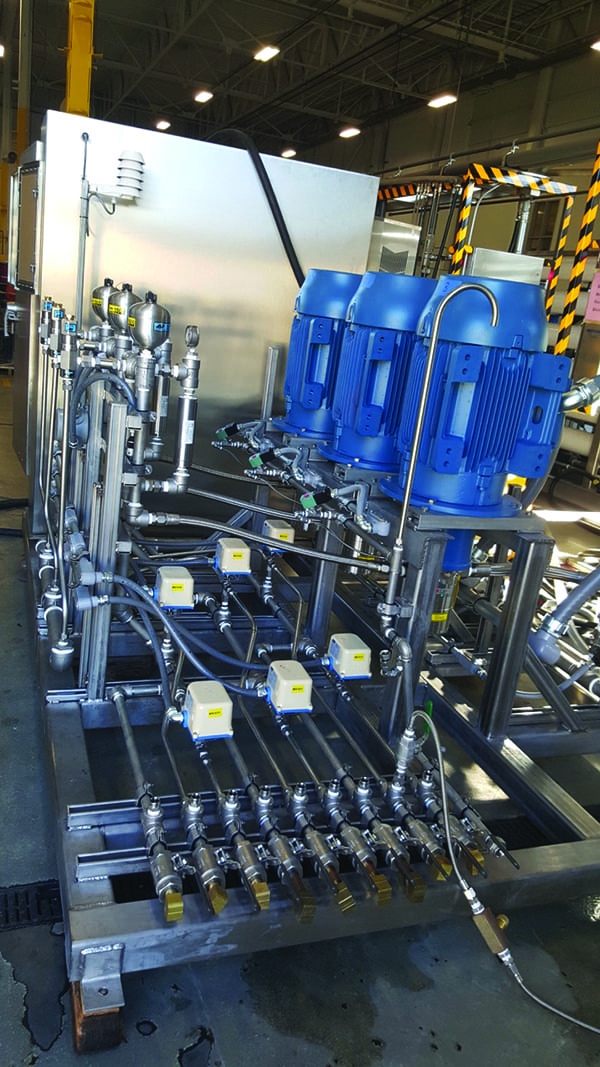Adding Fog for Power Augmentation and Emission Reduction
A pilot project was initiated by China’s largest energy provider to test the effectiveness of fog-based power augmentation for a gas turbine at a compressor station. The system provided a significant increase in power output, as well as a reduction in fuel consumption and NOx emissions. The boost in output enables the company to take adjacent turbines offline for maintenance without suffering extensively. The company also gained a means of containing fuel costs during periods of low demand.
China is in the midst of an unprecedented expansion of its pipeline network. The National Development and Reform Commission, and the National Energy Administration plan to establish a pipeline network of 240,000 kilometers (km) by 2025, up from about 150,000 km today. This will include 123,000 km of natural gas pipelines, enough to bring natural gas to every city in the nation with a population of at least half a million. These changes will boost the natural gas share of the Chinese energy mix to 10%.
But there is a long way to go. According to the International Energy Agency (IEA), China is set to become the world’s largest importer of natural gas this year. Despite a rise in homegrown gas field output, 45% of natural gas in China will come from external sources by 2023. IEA figures through 2035 show a continuing shortfall between local supply and national demand. Thus, there is heavy emphasis on infrastructure that can move gas rapidly from Russia to China, within China, and from liquefied natural gas (LNG) import terminals on the coast to the industrial heartland.
One of the many problems to overcome in any natural gas pipeline network is summer heat. As temperatures rise, the output of compressor stations falls, slowing the transmission of natural gas. In China’s Western Pipeline, therefore, a pilot project was initiated by China’s largest energy provider PetroChina West Pipeline Co. to test the effectiveness of fog-based power augmentation for a gas turbine at a compressor station.
The MeeFog system tested on a GE LM2500 turbocompressor provided a significant increase in power output, as well as a reduction in fuel consumption and NOx emissions. The boost in output enables PetroChina to take adjacent turbines offline for maintenance without suffering too much loss in throughput. The company also gained a means of containing fuel costs during periods of low demand by running one fewer machine.
Western Pipeline
China’s Western Pipeline is a recent addition to the nation’s network. It comprises more than 100 compressor stations. They are powered by approximately 80 GE LM2500 aeroderivative gas turbines, 30 Rolls-Royce RB211s, and 15 Solar Taurus turbocompressors. These stations move natural gas from the points of supply within and outside of China across vast distances to population centers.
Compressor stations basically function like large pumps. They are needed to continue the flow of gas along the pipeline to its destination. In summer, climbing temperatures cause compressor power output to fall, fuel usage to increase, and emissions to soar. This inhibits gas transportation. As compressor output drops, gas is pumped more slowly along the pipeline.
Experience around the world indicates that gas turbines produce up to 20% less power in summer than in winter. Power output of a turbine depends on the air mass flow. On hot days, air is less dense and air mass flow drops, causing power output to fall.
With natural gas in ever-higher demand in China’s industrial regions, there was a great need to strengthen the supply line of gas from the West. One possible solution was larger compressors, but China is also in the midst of a drive to lower emissions. Adding larger compressors would greatly increase cost and lead to more emissions and fuel cost would increase.
PetroChina decided to implement a MeeFog system on a GE LM2500 turbocompressor inside a compressor station within the pipeline to determine its viability within the network. While this technology may have proven itself over the past three decades in the West, it was the first such installation on a gas compression turbine in China. Fog-based evaporative cooling was evaluated as a possible way to improve gas transmission while containing costs, lowering fuel consumption, and curtailing emissions.
Lianmuqin Compressor Station
The Lianmuqin compressor station is situated in the vicinity of the city of Shanshan, Turpan Region in the Xinjiang Province of northwestern China. It lies east of Kyrgyzstan and Kazakhstan, and southwest of Mongolia. Gas is transported from Shanshan, thousands of miles to Shanghai and other eastern destinations.
The compressor station lies in a dry region. During summer, temperature increases curtail compressor output and slow the supply of gas to industrial centers. The station consists of three GE LM2500 turbocompressors. As fog systems were new to PetroChina, a MeeFog system was installed in one unit to determine its effectiveness. PetroChina selected the leader in high-pressure fog systems, Mee Industries of Irwindale, California.
Fog systems use high-pressure water pumps to pressurize demineralized water that flows through a network of stainless-steel tubes to fog nozzle manifolds installed in the air stream inside the inlet duct. These nozzles atomize the water into micro-fine fog droplets (Figure 1), which evaporate quickly and cool the air. By feeding cooler air into the compressor, mass flow is increased, resulting in higher output.
 |
|
1. Fog systems use high-pressure pumps and nozzles to atomize water, which cools the air going into compressors, resulting in higher output and lower NOx emissions from gas turbines. Courtesy: Mee Industries |
The fog system includes a series of high-pressure pumps (Figure 2), a programmable logic controller (PLC), and an array of fog nozzle manifolds. Each pump is connected to a fixed number of fog nozzles representing one discrete stage of fog cooling with eight stages in total at the compressor station. The pumps are turned on sequentially to control the amount of cooling.
 |
|
2. The MeeFog skid includes high-pressure pumps controlled by a programmable logic controller. Courtesy: Mee Industries |
Weather sensors are connected to the PLC to monitor ambient temperature and humidity. Proprietary control software by Mee Industries automatically turns on or off each stage of fog cooling depending on the capacity of the inlet air to absorb water vapor.
The nozzle manifolds and nozzles are made of stainless steel. In order to make droplets small enough to create a fog, impaction-pin nozzles are utilized. They produce fog droplets ideal for inlet air cooling and small enough to eliminate the possibility of compressor blade erosion that can be caused by large droplets. With a mean droplet size of about 10 microns, cooling efficiency is high and water wastage is minimal.
Fog System Evaluation
To evaluate the effectiveness of the MeeFog inlet air cooling system, PetroChina conducted an in-depth performance test on one GE LM2500 with a rated power of 31.4 MW. Its compressor is a model PCL 802 with a rated operating speed of 6,100 rpm.
Testing tools included a Testo 350 flue gas analyzer for emission measurement, and the KopFlex power test system for power measurement. The KopFlex system includes a torque test panel, a temperature/speed/torque three-in-one probe, a modulation unit, a display unit, and a 4–20 milliamp power signal output. Parameters measured included ambient air temperature, inlet air temperature and pressure, relative humidity, power turbine speed, fuel usage, compressor speed, and exhaust temperature and pressure.
PetroChina and its local equipment supplier Circuit Powertek of Shanghai tested the MeeFog system while it operated at three different compressor speeds: 4,505 rpm, 4,826 rpm, and 5,105 rpm. The test at 4,505 rpm was done when the ambient air temperature was at 23.5C. Once the fog system was running, technicians recorded an inlet air temperature drop of more than 7C, a fuel flow reduction of almost 3 kilogram/minute (kg/min), and a turbine power increase of almost 3 MW.
The test at 4,826 rpm was conducted when the ambient air temperature was at 21.5C. Once the fog system was running, technicians recorded similar numbers: a temperature drop of about 7C, a fuel flow reduction of just over 5 kg/min, and a turbine power increase of almost 3 MW. Further, the test at 5,105 rpm recorded a temperature drop of about 7C, a fuel flow reduction of just over 5 kg/min, and a turbine power increase of almost 3 MW.
Emissions Reduction
China is currently engaged in a major initiative to curb emissions. Average concentrations of 10 micrometer and smaller particulate matter (PM10) were down 22% in 2017 from 2013 levels in more than 300 cities. In Beijing, the average concentration of 2.5 micrometer and smaller particulate matter (PM2.5) was down about 35% in that same period.
In addition to these efforts at smog control in its industrial areas, China is adding large amounts of wind and solar power to the grid. Efforts are also underway to reduce emissions from industrial complexes, power plants, and oil and gas facilities. This includes the deployment of clean coal technologies, favoring natural gas over coal where feasible, and implementing a variety of measures to curtail emissions.
It was a definite bonus, then, to achieve emissions reductions due to the use of fog. By increasing the power output of the turbine, most people would expect that the level of NOx emissions would increase correspondingly. However, the opposite turned out to be true.
Gas turbine NOx comes from the oxidization of atmospheric nitrogen (that is, it is not a product of fuel; it comes from the air). NOx formation is a strong function of combustion temperature. However, the presence of water vapor in the combustion air reduces hotspots, which are the primary source of NOx. Thus, the quenching effect of fog makes it possible to raise power production while lowering NOx emissions levels.
Testing at all three compressor speeds confirmed this in the real world: at 4,505 rpm, NOx emissions were brought down by 27.4 ppm; at 4,826 rpm, NOx emissions were brought down by 13.6 ppm; and at 5,105 rpm, NOx emissions were brought down by 8 ppm.
A Successful Test
During the warmer summer months, the use of the MeeFog system significantly increased compressor output. This facilitated more rapid transportation of natural gas along the Western Pipeline to demand centers in the East.
The MeeFog system also reduced fuel consumption, which helps PetroChina to produce more compressor power in an economical manner. As fog systems are a tiny fraction of the cost of new gas turbines and compressors, this offered a way to improve pipeline efficiency without requiring a heavy upfront investment. The MeeFog system also demonstrated its environmental credentials by lowering NOx emissions. This materially assisted ongoing efforts to reduce pollution. Additionally, the low parasitic power needs of the MeeFog system was beneficial.
Finally, the addition of one fog system at the Lianmuqin compressor station enabled station personnel to enhance maintenance. As the fog system increased output at the station, PetroChina could easily take one turbine offline and only run two turbines instead of three. This heightened station efficiency and made equipment maintenance much simpler. ■
—Xiao Wang and Chen Cheng are engineer, equipment supervisors with PetroChina West Pipeline Co.